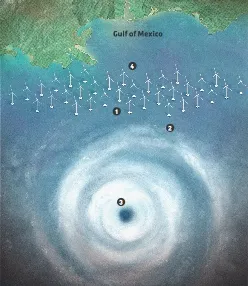Last year will go down in history as the yearof the hurricane. In 2017, three storms in the Gulf of Mexico and the Caribbean – Harvey, Irma and Maria – together took more than 300 lives and caused damage totalling $450bn (£319bn), making it the costliest Atlantic hurricane season ever.
Asclimate changebites ever harder, the most powerful hurricanes are forecast to become more frequent, so years like this may become the norm in decades to come. This has focused minds on ways of stopping hurricanes in their tracks, or even preventing them from forming at all.
One idea – known as the Salter Sink – has been patented by British marine engineer Prof Stephen Salter and billionaire philanthropist Bill Gates.
The plan is to float thousands of tyre-like rings in the tropical Atlantic, connected to giant tubes that suck warm surface waters down into deeper water, to be replaced by cold water from below.
Hurricanes need sea-surface temperatures of at least 26.5°C to form. If Salter and Gates’s gizmo was able to bring surface temperatures down below this, then hurricane formation would be impossible.
A modified version, patented by Gates and others, has the surface waters being cooled via tubes connected to a line of barges strung out in front of an oncoming storm.Yet a further scheme, put forward by the University of Manchester’s Dr John Latham and colleagues, visualises a fleet of unmanned ships roaming the tropical Atlantic.
These would spray tiny droplets of seawater into the atmosphere, which would make the clouds brighter so they reflect more of the Sun’s heat back into space. This would cool the sea surface beneath and hinder hurricane formation.
Esoteric geoengineering plans that involve messing about with ocean temperatures or cloud formation may, however, hold nasty surprises for global weather patterns.
A less risky way forward, then, might be to make use of a technology that is already being developed for a different purpose. At least, that’s what engineer Prof Mark Jacobson of California’s Stanford University and his co-workers think. If sited appropriately, they say, offshore wind farms could protect coastlines from approaching hurricanes.
Jacobson and his team used a computer model to simulate three of the most devastating hurricanes in recent years: Sandy, which battered New York in 2012, plus Isaac (2012) and Katrina (2005). Then they ran the simulations with giant, offshore wind farms strung across the paths of the storms, and the effect was by no means small.
They found that a huge wind turbine array off the coast of New Orleans could have reduced the peak wind speed of Hurricane Katrina by an astonishing 145km/h (90mph) or so, and the accompanying storm surge, which caused massive flooding, by close to 80 per cent.
Offshore wind turbines could have tempered the impact of Sandy too: the computer model projected a fall in wind speed of up to 140km/h (87mph), along with a storm surge two-thirds smaller.
Offshore wind farms sound like a tempting way of killing two birds with one stone, but there may be an issue with the huge numbers of turbines required: 78,000 would be needed to curb the impact of a Katrina-sized storm, for example.
The highest concentration of offshore wind farms todaycan be found in the North Sea, and consists of fewer than 1,500 individual turbines.
Still, it’s good to know that a green technology could be used to tackle the hurricane threat, and that it’s there if we want to use it.
How it works
Simulations suggest that wind farms could slow the speedof hurricanes.

- A giant wind farm, made up of tens of thousands of turbines, is constructed across one of the paths favoured by hurricanes in the tropical Atlantic or Gulf of Mexico.
- As the hurricane approaches the wind farm, the spinning turbine blades hinder and slow down the rotating winds in the outer parts of the storm. This reduces the height of the sea waves beneath the outer parts of the storm, which slows the movement of air towards the centre of the hurricane.
- This results in a rise in atmospheric pressure at the centre of the hurricane, reducing the pressure differential across the storm, slowing wind speeds throughout and dissipating the hurricane faster.
- As a bonus, the wind turbines generate enormous amounts of low-carbon energy.
Follow Science Focus onTwitter,Facebook, Instagramand Flipboard
